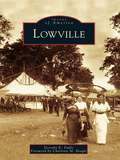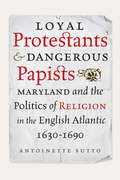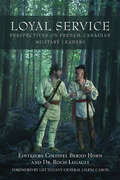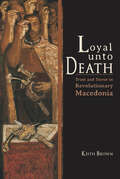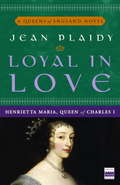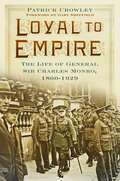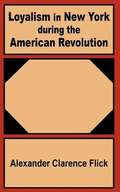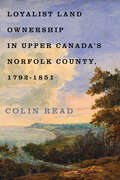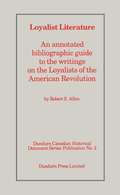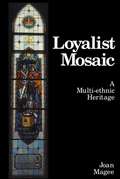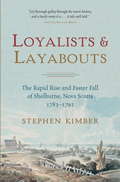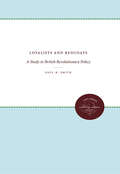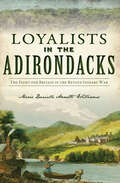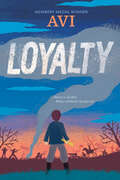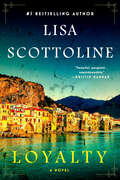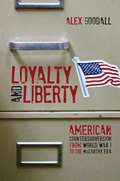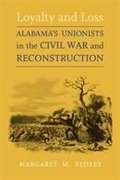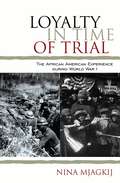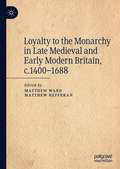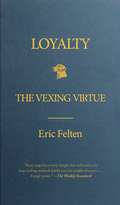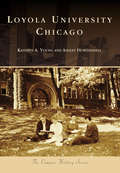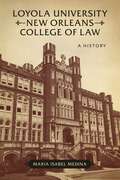- Table View
- List View
Lowville
by Charlotte M. Beagle Dorothy K. DufloLowville, first settled in 1796, is part of the Black River valley, an area laden with fertile land and rich forests. The town continued to develop through the years, supporting hotels, flour mills and gristmills, furniture manufacturers, cheese plants, tanneries, and even a brewery. Lowville's place in history was sealed when, by 1878, it was producing eight million pounds of cheese annually with a value at that time of $1 million. The earlier manufacturing businesses gradually faded, and Lowville ushered in the 20th century as an important dairy center, a tradition that continues to this day.
Loyal Protestants and Dangerous Papists: Maryland and the Politics of Religion in the English Atlantic, 1630-1690 (Early American Histories)
by Antoinette SuttoLoyal Protestants and Dangerous Papists analyzes the vibrant and often violent political culture of seventeenth-century America, exploring the relationship between early American and early modern British politics through a detailed study of colonial Maryland. Seventeenth-century Maryland was repeatedly wracked by disputes over the legitimacy of the colony's Catholic proprietorship. The proprietors' strange policy of religious liberty was part of the controversy, but colonists also voiced fears of proprietary conspiracies with Native Americans and claimed the colony's ruling circle aimed to crush their liberties as English subjects. Conflicts like these became wrapped up in disputes less obviously political, such as disagreements over how to manage the tobacco trade, without which Maryland's economy would falter. Antoinette Sutto argues that the best way to understand this strange mix of religious, economic, and political controversies is to view it with regard to the disputes over the role of the English church, the power of the state, and the ideal relationship between the two--disputes that tore apart the English-speaking world twice over in the 1600s. Sutto contends that the turbulent political history of early Maryland makes most sense when seen in an imperial as well as an American context. Such an understanding of political culture and conflict in this colony offers a window not only into the processes of seventeenth-century American politics but also into the construction of the early modern state. Examining the dramatic rise and fall of Maryland's Catholic proprietorship through this lens, Loyal Protestants and Dangerous Papists offers a unique glimpse into the ambiguities and possibilities of the early English colonial world.
Loyal Service: Perspectives on French-Canadian Military Leaders
by Colonel Bernd Horn Roch Legault Lieutenant-General J.H.P.M CaronFrench Canadians have a long, proud history of serving their nation. From the earliest beginnings, French Canadians assisted in carving out and defending the nascent country. They were critical as defenders and as allies against hostile Natives and competing European powers. In the aftermath of the conquest, they continued, albeit under a different flag, to defend Canada. Loyal Service examines the service of a number of French-Canadian leaders and their contributions to the nation during times of peace, crisis, and conflict spanning the entire historical spectrum from New France to the end of the twentieth century.
Loyal Unto Death: Trust and Terror in Revolutionary Macedonia (New Anthropologies of Europe)
by Keith Brown“The story of the Macedonian Revolutionary Organization (MRO) from its rise until the Illinden Uprising of 1903 . . . a fascinating account.” —PoLARThe underground Macedonian Revolutionary Organization recruited and mobilized over 20,000 supporters to take up arms against the Ottoman Empire between 1893 and 1903. Challenging conventional wisdom about the role of ethnic and national identity in Balkan history, Keith Brown focuses on social and cultural mechanisms of loyalty to describe the circuits of trust and terror—webs of secret communications and bonds of solidarity—that linked migrant workers, remote villagers, and their leaders in common cause. Loyalties were covertly created and maintained through acts of oath-taking, record-keeping, arms-trading, and in the use and management of deadly violence.“This book is, to my mind, exactly the kind of work that needs to be done in order to understand civil wars, insurgencies, nationalism, and rebellions, and to get away from what the author rightfully critiques as ‘pidgin social science.’” —Chip Gagnon, Ithaca College“An innovative work that should inspire debate.” —Slavic Review“A subtle and compelling account of revolutionary insurgency in turn-of-the-century Macedonia. His analytical focus on loyalties, rather than identities, goes beyond critiques of nationalism in enabling powerful new understandings of the region’s histories and its continuing social dynamics.” —Jane K. Cowan, University of Sussex
Loyal in Love: Henrietta Maria, Queen of Charles I (A Queens of England Novel #1)
by Jean PlaidyThe daughter of Henry IV of France, Princess Henrietta Maria, becomes a pawn in a political strategy to stabilize relations between two countries when her father marries her to Charles I of England. Sent abroad, she finds herself living in a Protestant country that views her own faith—Catholicism—with deep suspicion. Yet her new husband is a man of principle and integrity, and Henrietta and Charles fall deeply in love. Henrietta is passionate about her faith, however, and soon politically powerful people, namely Oliver Cromwell and his Puritans, turn her loyalty to her religion into a focal point for civil war. As the royal couple watch the fall of Thomas Wentworth, first Earl of Strafford, the rise of Puritanism, and Englishmen fight Englishmen, they are undeterred in their dedication to each other and in their belief in the divine rights of king and queen—even as spies lurk in their very own household. Loyal in Loveoffers an inside look at an unforgettable time in England’s history and at the life of a queen whose story of devotion and bravery has gone untold for too long. From the Trade Paperback edition.
Loyal to Empire: The Life of General Sir Charles Monro, 1860-1929
by Gary Sheffield Patrick CrowleyWinston Churchill did not describe General Sir Charles Monro in the most glowing terms. Referring to Monro’s brave decision to recommend a withdrawal from the Gallipoli disaster, Churchill said: ‘He came, he saw, he capitulated.’ Monro was one of a handful of senior officers selected to command a division with the British Expeditionary Force in 1914 and also led a corps on the Western Front as the war progressed. After Gallipoli he was instrumental in supporting the war effort from India as commander-in-chief and was directly involved in the aftermath of the Amritsar massacre by Brigadier General Dyer. His earlier life included distinguished service on the North West Frontier and in South Africa, and he was responsible for dramatically improving tactics within the army. Loyal to Empire brings to life the interesting character of General Monro, perhaps the least well known of all the British First World War commanders, and reassesses the legacy of his important military contributions.
Loyalism in New York During The American Revolution
by Alexander Clarence FlickClassic study including extensive appendix of forfeited estates. Topics include the rise of the Loyalist Party, final organization, war against the loyalists, county inquisitorial organizations, activities of loyalists after issuance of the Declaration of Independence, activities of the commissioners on loyalists (1776-81), confiscation and sale of the property of loyalists, emigration of loyalists to Great Britain, Canada and Nova Scotia, and treatment of loyalists by Great Britain.
Loyalist Land Ownership in Upper Canada’s Norfolk County, 1792–1851 (McGill-Queen's Rural, Wildland, and Resource Studies)
by Colin ReadAfter the American Revolution, many Loyalists moved north, where the British colonial government awarded them generous land grants on favourable terms. The intention behind these grants was to create a landed gentry in Upper Canada that would safeguard the colony’s political security and build social cohesion among its leadership.Loyalist Land Ownership in Upper Canada’s Norfolk County, 1792–1851 examines the long-term landholding of Loyalists and other settlers who arrived in the county before 1812 to judge whether this social experiment succeeded. Colin Read explores the various ways that settlers acquired and transmitted land, the nature of familial land sales, and the place of women in owning land. Consulting land records and genealogical research, he finds that no landed elite endured in Upper Canada: Loyalists owned only marginally more land than non-Loyalists by 1851, and it was commonplace for latecoming settlers to eventually own land. Yet early arrival was a significant determinant of later landholding and property size – it mattered who settled first.Land was the main source of wealth in early Canada. This fine-grained study sheds light on how it was acquired, disposed of, and passed down through generations in the nineteenth century. Although a landed aristocracy was never realized, the colonial state’s allocation of land to settlers laid the foundation for their social standing.
Loyalist Literature
by Robert S. AllenThis highly readable guide is more than a bibliography. Written in a narrative style, it is as well a short history of the Loyalists: who they were, why they left, where they settled, and what their legacy is.
Loyalist Mosaic: A Multi-Ethnic Heritage
by Joan MageeLoyalist Mosaic highlights the ethnic diversity among the Loyalist settlers to Canada by exploring the experiences of 11 extraordinary individuals.
Loyalists and Layabouts
by Stephen KimberMarking the 225th anniversary of loyalist landings in Canada, this important and comprehensive history is essential reading on the shaping of our country. The few hundred loyalists who gathered at Roubalet's Tavern in New York on the night of Saturday, November 16, 1782, shared a vision of the future intended to sustain them through the nightmare of the present. Abandoned by the king to whom they had promised their loyalty, unwelcome in the land that had so recently been theirs, they had no choice but to flee. But to where? And for what? Their dream was to build a new and improved New York City. They would do this on the rocky shores of Roseway Bay, on the south coast of Nova Scotia, beside one of the best harbours in the world. The city would be cosmopolitan, but more refined, more royal, more loyal, and certainly more exclusive than the one they were now preparing to leave behind forever. At first, it seemed as if their dream would come true. Within the decade, however, Shelburne was a wasteland of abandoned homes and shops.What happened? Plagued by drought, fires, and poor land quality, Shelburne's fortunes quickly fell. Vividly told through the intertwined narratives of an eclectic collection of its early settlers, Loyalists and Layabouts is the fascinating story of Shelburne's "rapid rise and faster fall."From the Hardcover edition.
Loyalists and Redcoats: A Study in British Revolutionary Policy (Published by the Omohundro Institute of Early American History and Culture and the University of North Carolina Press)
by Paul H. SmithFocusing on the role of the American Loyalists in Great Britain's military policy throughout the Revolutionary War, this book also analyzes the impact of British politics on plans to utilize those colonists who remained faithful to the Crown. The capacity of the Loyalists to affect the war's outcome was directly tied to their projected role in British plans and their contribution can be understood only in relation to British efforts to organize them.Originally published in 1964.A UNC Press Enduring Edition -- UNC Press Enduring Editions use the latest in digital technology to make available again books from our distinguished backlist that were previously out of print. These editions are published unaltered from the original, and are presented in affordable paperback formats, bringing readers both historical and cultural value.
Loyalists in the Adirondacks: The Fight for Britain in the Revolutionary War
by Marie Danielle WilliamsFrom the outbreak of the Revolutionary War to the summer of 1777, Loyalists and Patriot forces wove their way through the mountains and valleys of the Adirondacks, vying for land and control of the key waterways of the Hudson River, Lake Champlain, the St. Lawrence River and the New York Harbor. The majority of New Yorkers, particularly those who occupied the Adirondack Mountain Region and other wilderness frontier regions, were either Loyalist or neutral throughout the war. Their stories, motivations and actions are often overlooked out of a false impression that most colonists were unifed in favor of American independence. Author Marie Williams recounts the harrowing efforts, battlefield endeavours and conflicted hearts and minds of the forgotten British and Loyalists during the revolutionary era in the Adirondacks.
Loyalties in Conflict
by John LittleDespite their strategic location on the American border, the townships of Lower Canada have been largely ignored in studies of the War of 1812 and the Rebellions of 1837-38. Originally settled by Loyalists from New York, and followed by much larger numbers of land seekers from New England, this was a potentially volatile borderland during British-American conflicts. J.I. Little's Loyalties in Conflict examines how the allegiance to British authority of the American-origin population within the borders of Lower Canada was tested by the War of 1812 and the Rebellions of 1837-1838. Little argues that while loyalties were highly localized, American border raids during the war caused a defensive reaction north of the 45th parallel. The resulting sense of distinction from neighbouring Vermont, with its radical religious and political culture, did not prevent a strong regional reform movement from emerging in the eastern townships during the 1820s and 1830s. This movement undermines the argument of Quebec's nationalist historians that the political contest in Lower Canada was essentially a French-English one, but the dual threat of French-Canadian and American nationalism did ensure the border townships's loyalty to the government during the rebellions. The following years would witness the development of an increasingly conservative and distinctly Canadian cultural identity in the region. A rigorous study of a pivotal period in North American history, Loyalties in Conflict is a fascinating account of conflicting forces in one region that, like the rest of Canada, has been largely shaped by the interaction of American and British influences, as well as French-language and English-language ones.
Loyalties: A Son's Memoir
by Carl BernsteinThe events that shaped the author's childhood and led to the persecution of his parents during the McCarthy era.
Loyalty
by AviNewbery Medalist Avi explores the American Revolution from a fresh perspective in the story of a young Loyalist turned British spy navigating patriotism and personal responsibility during the lead-up to the War of Independence.When his father is killed by rebel vigilantes, Noah flees with his family to Boston. Intent on avenging his father, Noah becomes a spy for the British and firsthand witness to the power of partisan rumor to distort facts, the hypocrisy of men who demand freedom while enslaving others, and the human connections that bind people together regardless of stated allegiances. Awash in contradictory information and participating in key events leading to the American Revolution, Noah must forge his own understanding of right and wrong and determine for himself where his loyalty truly lies.
Loyalty
by Lisa Scottoline#1 bestselling author Lisa Scottoline presents Loyalty, an emotional, action-packed epic of love and justice, set during the rise of the Mafia in Sicily. Loyalty can save a soul—or destroy one. Franco Fiorvanti is a handsome lemon grower toiling on the estate of a baron. He dreams of owning his own grove, but the rigid class system of Sicily thwarts his ambition. Determined to secure a better future, Franco will do anything to prove his loyalty to the baron. But when the baron asks him to kidnap a little boy named Dante, Franco makes a decision that will change his life—and even the history of Sicily—forever. Gaetano Catalano is an idealistic young lawyer whose devotion to justice is tantamount to a calling. He&’s a member of the Beati Paoli, a real-life secret society of aristocrats who investigate crime in Palermo, a city riddled with graft. Gaetano sets out to find the boy and punish the kidnapper, but his mission leads him to a darker place than he had ever imagined. Meanwhile, Mafalda Pancari is a new mother rejoicing at the birth of her daughter, Lucia, when disaster strikes. And Alfredo D&’Antonio is a reclusive goatherd under constant threat of being discovered as a Jew. How the lives of these unforgettable characters collide makes Loyalty an epic tale of good versus evil, as the story twists and turns to its monumental showdown. Readers will be transported to the dramatic and ruggedly beautiful island of Sicily, the jewel of the Mediterranean, where lush lemon groves and mouth-watering cuisine contrast with a turbulent history of colonization and corruption. Scottoline brings her decades of thriller writing to historical fiction, creating in Loyalty a singular novel that no reader will be able to put down.
Loyalty First: The Life and Times of Charles A. Willoughby, MacArthur's Chief Intelligence Officer
by David A. FoyFinalist, 2023 Army Historical Foundation Distinguished Writing Awards" ...provides critical texture to a historical figure often left pilloried without full context. The balanced treatment of a complex, flawed leader is valuable to understanding MacArthur’s command and an instructive lesson for today’s intelligence professionals and those who rely on intelligence to guide their decisions." — Aether: A Journal of Strategic Airpower & Spacepower Major General Charles A. Willoughby served as Douglas MacArthur's stalwart chief intelligence officer (G-2} for over a decade, throughout World War II and the Korean War. This first full biography examines Willoughby's shadowy origins in his native Germany, his curious arrival in the United States, and his military service in World War I, as well as his work during the interwar years as a junior diplomat, budding historian, and neophyte intelligence officer. His chance encounter with MacArthur in the mid-1930s would prove to be the genesis of a near-symbiotic relationship between the two, with significant consequences for both. Throughout his life, Willoughby identified with strong, authoritarian leaders, notably Franco, and—especially—MacArthur. The author also assesses Willoughby's performance as a professional intelligence officer both in World War II and Korea, where he is often vilified for his inaccurate assessments of enemy strength and most likely courses of action, as well as his sycophantic relationship with his commander. Willoughby is most often criticized for his failing to foresee the entry of Chinese forces into the Korean War and its impact upon the US Army and the prosecution of the war. Following MacArthur’s removal by President Truman in 1951, Willoughby retired and spent the rest of his days engaged in right-wing political activity and in staunchly defending his much-maligned boss. The legacy he left is one filled with lingering and important questions about loyalty to superiors, in civilian as well as military environments, how far that loyalty should extend, and walking the tightrope involved in telling truth to power.
Loyalty and Liberty: American Countersubversion from World War 1 to the McCarthy Era
by Alex GoodallLoyalty and Liberty offers the first comprehensive account of the politics of countersubversion in the United States prior to the McCarthy era. Alex Goodall traces the course of American countersubversion over the first half of the twentieth century, culminating in the rise of McCarthyism and the Cold War. This sweeping study explores how antisubversive fervor was dampened in the 1920s in response to the excesses of World War I, transformed by the politics of antifascism in the Depression era, and rekindled in opposition to Roosevelt's ambitious New Deal policies in the later 1930s and 1940s. Varied interest groups such as business tycoons, Christian denominations, and Southern Democrats as well as the federal government pursued their own courses, which alternately converged and diverged, eventually consolidating into the form they would keep during the Cold War. Rigorous in its scholarship yet accessible to a wide audience, Goodall's masterful study shows how the opposition to radicalism became a defining ideological question of American life.
Loyalty and Loss: Alabama's Unionists in the Civil War and Reconstruction (Conflicting Worlds Series)
by Margaret M. StoreyThough slavery was widespread and antislavery sentiment rare in Alabama, there emerged a small loyalist population, mostly in the northern counties, that persisted in the face of overwhelming odds against their cause. Margaret M. Storey’s welcome study uncovers and explores those Alabamians who maintained allegiance to the Union when their state seceded in 1861--and beyond. Storey’s extensive, groundbreaking research discloses a socioeconomically diverse group that included slaveholders and nonslaveholders, business people, professionals, farmers, and blacks. By considering the years 1861–1874 as a whole, she clearly connects loyalists’ sometimes brutal wartime treatment with their postwar behavior.
Loyalty in Time of Trial: The African American Experience During World War I (The African American Experience Series)
by Nina MjagkijThe little-known history of black soldiers and defense workers in the First World War, and what happened afterward: &“Highly recommended.&” —Choice In one of the few book-length treatments of the subject, historian Nina Mjagkij conveys the full range of the African American experience during the &“Great War.&” Prior to World War I, most African Americans did not challenge the racial status quo. But nearly 370,000 black soldiers served in the military during the war, and some 400,000 black civilians migrated from the rural South to the urban North for defense jobs. Following the war, emboldened by their military service and their support of the war on the home front, African Americans were determined to fight for equality—but struggled in the face of indifference and hostility in spite of their combat-veteran status. America would soon be forced to confront the impact of segregation and racism—beginning a long, dramatic reckoning that continues over a century later. &“Painstakingly describes the frustration, sometimes anger, and frequent courage demonstrated by southern and northern African Americans in their attempts to include themselves in the national crusade of making the world safe for democracy . . . one of the most comprehensive treatments of the race issue in the early twentieth century that this reader has seen.&” —Journal of Southern History
Loyalty to the Monarchy in Late Medieval and Early Modern Britain, c.1400-1688
by Matthew Ward Matthew HefferanThis book explores the place of loyalty in the relationship between the monarchy and their subjects in late medieval and early modern Britain. It focuses on a period in which political and religious upheaval tested the bonds of loyalty between ruler and ruled. The era also witnessed changes in how loyalty was developed and expressed. The first section focuses on royal propaganda and expressions of loyalty from the gentry and nobility under the Yorkist and early Tudor monarchs, as well as the fifteenth-century Scottish monarchy. The chapters illustrate late-medieval conceptions of loyalty, exploring how they manifested themselves and how they persisted and developed into early modernity. Loyalty to the later Tudors and early Stuarts is scrutinised in the second section, gauging the growing level of dissent in the build-up to the British Civil Wars of the seventeenth century. The final section dissects the role that the concept of loyalty played during and after the Civil Wars, looking at how divergent groups navigated this turbulent period and examining the ways in which loyalty could be used as a means of surviving the upheaval.
Loyalty: The Vexing Virtue
by Eric FeltenA witty, provocative, story-filled inquiry into the indispensable virtue of loyalty--a tricky ideal that gets tangled and compromised when loyalties collide (as they inevitably do), but a virtue the author, a prizewinning columnist for The Wall Street Journal, says is as essential as it is impossible. Felten illustrates the push and pull of loyalties-- from the ancient Greeks to Facebook--with stories and scenarios in which conflicting would-be moral trump cards trap the unlucky in painful ethical dilemmas. The foundation of our greatest satisfactions in life, loyalty also proves to be the root of much misery. Can we escape the excruciating predicaments when loyalties are at loggerheads? Can we avoid betraying and being betrayed? When looking for love and friendship--the things that make life worthwhile--we are looking for loyalty. Who can we count on? And who can count on us? These are the essential (and uncomfortable) questions loyalty poses. Loyalty and betrayal are the stuff of the great stories that move us: Agamemnon, Huck Finn, Brutus, Antigone, Judas. When is loyalty right, and when does the virtue become a vice? As Felten writes in his thoughtful and entertaining book, loyalty is vexing. It forces us to choose who and what counts most in our lives--from siding with one friend over another to favoring our own children over others. It forces us to confront the conflicting claims of fidelity to country, community, company, church, and even ourselves. Loyalty demands we make decisions that define who we are.
Loyola University Chicago (Campus History)
by Kathryn A. Young Ashley HowdeshellFor the past 150 years, since its founding in 1870 as St. Ignatius College, Loyola University Chicago has served and educated both the immigrant and established residents of Chicago, excelling in providing a comprehensive liberal arts education. One of the largest Jesuit universities in the United States, Loyola Chicago offers over 80 undergraduate and 170 graduate and professional programs in the humanities, sciences, medicine, nursing, social work, law, business, and communications on four campuses--three in Chicago and one in Rome, Italy. Now in its second century of service, and with an enrollment of over 17,000 students and 150,000 alumni, half of whom live in Chicago, Loyola continues its mission of preparing people to lead extraordinary lives.
Loyola University New Orleans College of Law: A History
by Maria Isabel MedinaMaria Isabel Medina's chronicle of Loyola University New Orleans College of Law examines the prominent Jesuit institution across its hundred-year history, from its founding in 1914 through the first decade of the twenty-first century. With a mission to make the legal profession attainable to Catholics, and other working-class persons, Loyola's law school endured the hardships of two world wars, the Great Depression, the tumult of the civil rights era, and the aftermath of Hurricane Katrina to emerge as a leader in legal education in the state. Exploring the history of the college within a larger examination of the legal profession in New Orleans and throughout Louisiana, Medina provides details on Loyola's practical and egalitarian approach to education. As a result of the school's principled focus, Loyola was the first law school in the state to offer a law school clinic, develop a comprehensive program of legal-skills training, and to voluntarily integrate African Americans into the student body.The transformative milestones of Loyola University New Orleans College of Law parallel pivotal points in the history of the Crescent City, demonstrating how local culture and environment can contribute to the longevity of an academic institution and making Loyola University New Orleans College of Law a valuable contribution to the study of legal education.
